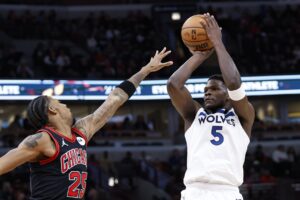The Boston Celtics’ addition of Gordon Hayward coupled with the selection of Jayson Tatum in the 2017 NBA Draft adds two more forwards to contribute to Boston’s combo forward obsession. The ideal vision that Brad Stevens and Danny Ainge have for the future of basketball is becoming more and more clear with every move made by Ainge: five players who can all space the floor, defend multiple positions, and create off the dribble for others.
With Hayward, Tatum, Jae Crowder, Jaylen Brown, and Marcus Morris, the Celtics now have five players in the top eight of their rotation who would each be considered wings by every NBA front office. So, what is it about Stevens’ offensive philosophy that allows him to play so many position-less players?
Film Analysis: The Boston Celtics Offense
Five Out Motion
Boston is one of the few teams in the NBA that truly goes five out, even when its bigs are on the court. Al Horford (and previously Kelly Olynyk) will often operate as a perimeter player, opting to drive and kick or run a dribble handoff (DHO) from outside the arc. If either big does decide to post up, it’s often a quick post before filling the vacant perimeter spot.
Below, Horford sets a high screen for Marcus Smart before popping out to the top of the key:
When the high screen forces the switch, Horford immediately goes to the post in an effort to take advantage of his mismatch. Bradley Beal recognizes this mismatch and decides to help down onto Horford. Unfortunately for the Wizards, while helping down, Beal loses track of Avery Bradley, who pops out to the corner for the open three-pointer.
Below, Smart sits in the post after his cut before setting a high screen for Isaiah Thomas. Notice how interchangeable each position is for Boston offensively. In this lineup, Smart is at nominal power forward spot, with Thomas, Terry Rozier, and Bradley at the one, two, and three positions, respectively. Stevens doesn’t hesitate to experiment with his lineups. Next season, expect Boston to tinker with small ball lineups that include Crowder and Morris at the four and five.
In the above clip, Horford spots up in the corner, drawing Marcin Gortat away from the rim, while Smart sets a high screen. Boston’s small-small pick-and-roll opens the lane for Thomas and doesn’t allow the Wizards to provide adequate help.
Below, Olynyk takes his man off the dribble from the perimeter before kicking the ball out:
Notice how open the lane is when Olynyk makes his move to the rim. This action scrambles Washington’s defense before Smart penetrates off the drive and kick for the easy floater. When all five positions on the floor can handle and shoot the ball, it puts an enormous amount of pressure on the defense to stick to their original assignments, making it difficult to help. Now, envision a player like Marcus Morris or Jayson Tatum occupying one of the Celtics’ frontcourt positions and taking advantage of the space created in five out action. Given Olynyk’s success in Boston, those two will surely find themselves in even better spots.
Below, Olynyk catches the ball on the perimeter and swings it to the top of the key before setting a high screen:
Watch Beal get pulled to the corner by Jonas Jerebko’s shooting threat, taking him away from the help side. This opens the lane for a simple pick-and-roll between Olynyk and Smart.
Below, Boston runs a similar action, but this time, Ian Mahinmi recovers to stop the pick-and-roll:
When Olynyk retreats to the perimeter, he tries to initiate a dribble handoff with Isaiah Thomas. This action is cut off by Washington’s stingy defense. However, Olynyk makes a nice spin move away from the DHO and is able to take advantage of the open lane he created for himself. Notice the spacing Boston creates on this possession. If any defender had been able to help down, this sequence probably wouldn’t happen. But, because Boston has players at every position who can either shoot or create off the dribble, the lane remains vacant.
Four-Out Post
Boston will often fluctuate between four out and five out action, particularly when Horford is on the court. Boston’s offensive system isn’t a “one or the other” proposition. It’s a collaborative flow that sees players at each position rotate around the perimeter and fluctuate in and out of post positions. The one exception to this is when Boston plays a traditional big who isn’t comfortable handling the ball on the perimeter. Last year, this role was given to either Amir Johnson or Tyler Zeller.
This year, any half court possessions with Boston’s newly signed Aussie big man, Aron Baynes, or rookie European center Ante Zizic on the court will call for four out action with Baynes or Zizic as the inside screener. The four out action often doesn’t open up the lane as well as Boston’s five out action does, but it still does a great job of opening up looks on the perimeter off of relocations, split screens, back screens, and flare screens.
Below, Johnson is operating as the post player in Boston’s four out action:
Olynyk screens away for Isaiah Thomas before fading to the top of the key. Markieff Morris hedges hard towards Thomas and is unable to recover in time to contest the open Olynyk three. The same perimeter pick-and-pop action that was seen in Boston’s five out offense remains present when Boston adds a post player to its lineup.
Below, Bradley and Horford start their action from the block, but Johnson actually operates as the post player in this sequence:
Notice the motion action here, as Johnson sets the pin down for Bradley, and Horford re-screens for Bradley after he loops back around to the corner. Gortat is forced to hedge two off-ball screens and show help side all before the final action of a high screen between Horford and Thomas. Excellent ball movement and motion action can really tire out opposing defenders. Gortat doesn’t hedge the final high screen at all, allowing Thomas to get a pretty open look from three.
Below, Horford operates the inside post position in a quick-hitter that’s designed to flow into Boston’s four out perimeter motion:
Watch how wide Thomas takes John Wall on his cut through the lane before accelerating to the corner as Horford pins Wall.
Below, Horford screens and re-screens to get Thomas an open look from the top of the key:
Notice how the initial Horford screen for Rozier forces Gortat to hedge. When Horford releases to go screen for Thomas, Gortat is unable to recover from his initial hedge to provide a contest on the second screen.
Below, Horford operates in the pinch post in what turns out to be a loose triangle action:
The Celtics don’t intentionally run a lot of triangle action, but because of the looseness and freedom of their offense combined with their heavy use of dribble handoffs and flare screens, they sometimes use a few triangle elements. Bradley throws the entry pass to Horford before using the Crowder screen to flare out for the open three.
Freedom/Transition
The Celtics will embrace shots early in the shot clock. As with any offense that encourages early, rhythm shots, Boston can be incredibly inconsistent. However, if the team strings a few three-pointers together, it can turn close games into 20-point leads over the course of five minutes. This sort of freedom allows players to get shots off in rhythm in exchange for a team’s ability to dictate the pace. In contrast to Hayward’s previous team, the Utah Jazz, who prioritized execution over tempo (ranking dead last in pace as a team last year), Boston’s philosophy encourages offensive freedom.
Below are two clips of Celtics bigs setting high screens in transition. In the first, Olynyk sets a ball screen early in the shot clock that allows Thomas to release a contested pull-up three. In the second, Smart finds Horford on a simple pick-and-roll. Notice how early in the shot clock each of these screens are set, not allowing the defense to fully recover:
Strategizing to get offensive production in transition makes incorporating new players much easier. Stevens isn’t fully responsible for balancing looks between Thomas and Hayward because many of those looks are developing organically.
Below, Boston runs another quick-hitter as a prerequisite to its motion action:
The two-man give-and-go action between Horford and Thomas effectively serves as a dribble handoff. Gortat is caught flat footed and fails to contest the Thomas mid-range jumper. Notice how Horford pops to the top of the key to give Thomas a perimeter outlet if an open look doesn’t come from the quick-hitter. The offense is designed to never stagnate, with perimeter players filling open space around the arc and continuing the five out action.
Stagger Dribble Handoff
One of Boston’s favorite specific sets is a three-man action that involves Horford initiating a dribble handoff towards Thomas, who loops up away from the baseline, while a stagger screen comes from another Boston wing. Last year, this stagger screen was usually set by Jae Crowder. Hayward also fits in perfectly as the stagger screener, and Boston’s most lethal action next year should be this stagger DHO between Thomas, Hayward, and Horford.
Below, Horford initiates the DHO:
Crowder sets the stagger as Thomas runs off the screen to take the DHO from Horford. Crowder then pops to the three-point line and drills the open triple.
Below, Olynyk initiates the DHO:
Crowder is again the stagger screener with Avery Bradley this time receiving the DHO. Bradley opts to rise and shoot the open jumper, but notice how open Crowder once again gets by fading to the open three-point line.
Below, Horford is back to handling the DHO:
Bradley receives the handoff with plenty of space to turn and drive to the rim. Crowder is again wide open at the top of the key. The addition of Hayward as an offensive weapon should open up even more space in this action.
Below is a variant of this stagger DHO that comes from triangle action with Horford in the pinch post:
Crowder sets a flare screen, but Bradley receives the handoff instead of flaring to the three-point line. This opens up space for Crowder to relocate after setting his flare screen and drill the open three.
Boston is taking the NBA’s trend towards versatility to the absolute extreme, already filling up eight of its roster spots with combo forwards. There’s a good chance that some Celtics lineups will have all five positions occupied by natural small forwards. Whether Boston can actually compete with the Cleveland Cavaliers is another story, but the Celtics’ positional experimentation will at the least provide a radically different look next season.
Main Photo:






